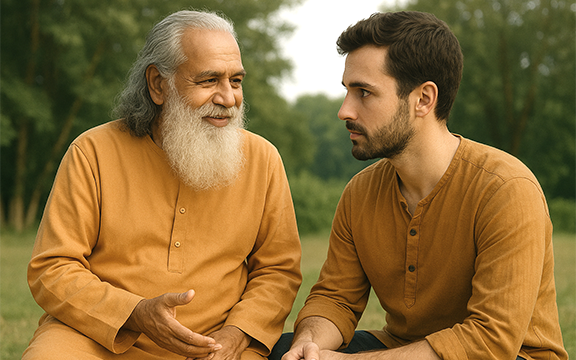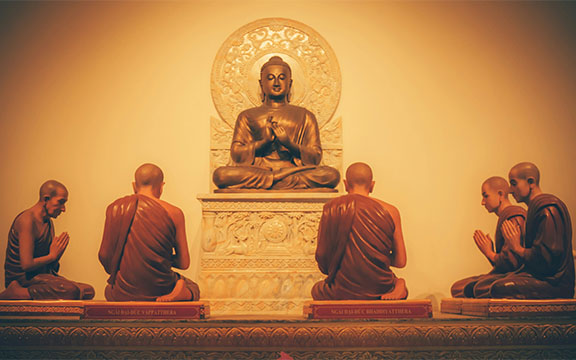
A Guru and his disciple. Photo courtesy of Mira Spencer.
Throughout history, seekers have turned to spiritual masters for guidance. While scriptures and saints of the past offer enduring wisdom, there is something uniquely powerful about the presence of a living master—a person who embodies spiritual truth in the here and now.
A living master serves as a bridge between the timeless and the timely. They translate age-old truths into practical guidance for modern life, meeting the needs of a world in flux. As technology reshapes how we live and relate, as minds evolve with each generation, the living presence of a realized being offers relevance, immediacy, and living proof that the divine can be realized in this very life.
Why a Living Master?
Spiritual realization is not just a philosophy; it is an experience. A living master shows us what that looks like. Not as an abstract idea, but in the middle of ordinary life—with its responsibilities, challenges, and opportunities.
In our age of endless information and limited attention, many young people are uninspired by traditional religion or institutional authority. They may find it difficult to relate to ancient texts or teachers long gone. Yet the human longing for meaning remains.
This is where the presence of a living guide becomes invaluable. The living master doesn’t simply teach; they live the teachings. They become a living answer to our spiritual questions. Their life becomes their scripture.
Who Is a Living Master?
A true master is not necessarily someone with followers or fame, but one who has transcended the limitations of ego and lives in service to truth. They radiate a rare combination of humility, wisdom, and love. They may not look extraordinary, but their presence uplifts, their words ring true, and their guidance inspires transformation.
History has known many such figures. Today, we are fortunate that there are masters walking among us still—guides who show by example how to live a life of inner depth while fully participating in the world.
How Do We Recognize One?
There is no single test to identify a spiritual master. Each seeker must follow the compass of their own heart. Spend time with the teacher. Practice what is given. Watch your own heart. Do you feel more peaceful? More loving? More aware? A genuine master doesn’t demand belief—they offer a path to personal experience.
Just as the Buddha sought guidance from various teachers until he ultimately found his own path, each seeker must remain open yet discerning. The spiritual path is deeply personal, and so is the resonance between student and guide.
Beyond Appearances
It’s a common misconception that a true master must be flawless in every way. We often equate holiness with perfection. But spiritual maturity isn’t always dressed in spotless robes or glowing charisma. A true master doesn’t pretend to be perfect. Their greatness lies in their authenticity, not their image. Their power is not in never making mistakes, but in the purity of their intent, the humility of their heart, and the selflessness of their actions.
Even great teachers of the past—whether Jesus, Krishna, or the Buddha—were seen by some as controversial or imperfect in their own time. The divine expresses itself in human form, and the human condition is full of paradoxes. What matters is not outer perfection, but inner realization.
The Role of Ego and the Gift of Humility
One of the central tasks of spiritual growth is to refine the ego—to move from separation toward unity. The ego says “I am the doer,” while humility opens us to grace. A true master lives in that space of surrender. They model how to act without attachment, to serve without pride, and to love without condition. Their humility is not weakness but strength—the strength to bow before truth, to receive divine inspiration, and to guide others without needing to control them.
Following such a master helps us see our own blind spots. The world may offer feedback, but only a loving guide can mirror our inner struggles with both honesty and compassion. They hold us accountable not by force, but by love.

Photo by Tien Vu Ngoc courtesy of unsplash.com
The Limitations of Organized Religion
There is nothing wrong with the great masters of the past—Jesus, the Buddha, Mahavira, Nanak, and others. Their teachings remain luminous. But over time, many of those teachings have been clouded by layers of interpretation, institutionalization, and dogma.
When teachings become rigid, when ritual replaces realization, when power structures overshadow inner freedom, the original spark is lost. Religion can become a shell without spirit. That is why the presence of a living guide is so vital. They help us rediscover the essence behind the form, the spirit behind the scripture. They speak in the language of today, while pointing to the eternal.
A Time of Change—and a Need for Guidance
We are living in a time of profound upheaval. Climate disruptions, social polarization, and existential uncertainty shake the foundations of our world. When outer structures fail, people turn inward. In such times, new spiritual movements often emerge—born not of dogma but of necessity. A living master becomes not just a guide for individuals but a lighthouse for entire societies searching for direction.
Some Living Masters of Our Time
Some of the living teachers who have gained respect across diverse traditions include H. H. the Dalai Lama, Amma (Sri Mata Amritanandamayi), Eckhart Tolle, Pema Chodron, Rupert Spira, Swami Sarvapriyananda, Mingyur Rinpoche. While each has a different approach, they share a focus on compassion, presence, and direct realization.
Ultimately, it’s not about choosing a famous teacher—it’s about finding one whose presence uplifts and whose teachings resonate with your heart. A true master encourages independence, not dependence; freedom, not blind faith. The purpose of a living master is not to attract followers, but to awaken seekers. Their example invites us to look within and live with greater love, clarity, and purpose.
Walking the Path
To walk with a living master is to witness a life of alignment. The master’s outer life reflects their inner state: calm, sincere, and rooted in truth. We don’t follow a master to copy their personality—but to awaken our own potential.
Daily spiritual practice, self-inquiry, and humility help us walk this path. Whether we draw inspiration from the Buddha, Christ, the Upanishads, or a living teacher’s words, the real journey is inward. The path is not about perfection but sincerity. With discernment, devotion, and steady effort, each of us can realize the divine within. The living master simply shows us that it is possible—and that it is now.
 About the Author:
About the Author:
Victor Kannan has been an avid practitioner of Heartfulness Meditation and a trainer for more than 30 years. As a career CFO he has been able to combine the benefits of meditation in the everyday management of his duties and responsibilities. He lives with his wife and daughter in Atlanta, Georgia.

